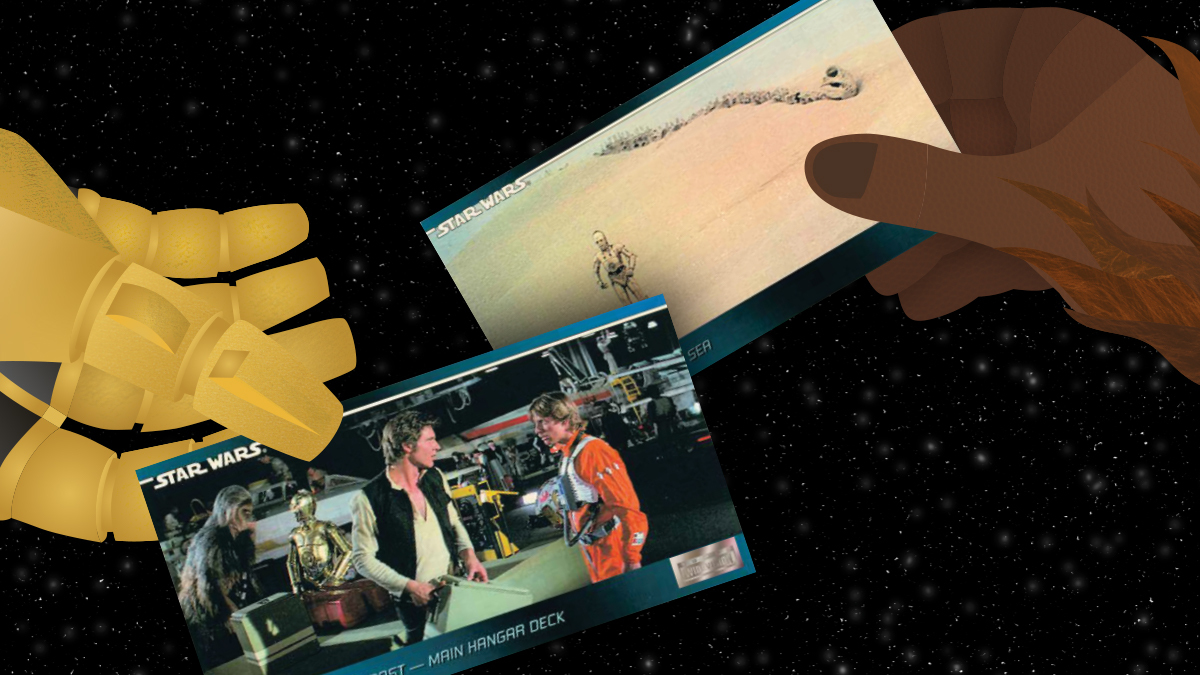The History of Star Wars Widevision Cards
25 years ago, Topps brought the most faithful cinematic representation of a galaxy far, far away to trading cards.

Presented by: 
This story appears in the Den of Geek x eBay special edition trading card magazine.
The notion of somehow making Star Wars bigger seems ridiculous in 2020, but 25 years ago, that’s precisely what The Topps Company did with the Star Wars Widevision trading cards. The result was not only groundbreaking for movie trading cards, but the 1995 Widevision series literally made Star Wars bigger for Topps with a legacy that continues more than two decades later.
“Star Wars cards in general are part of the legendary Star Wars experience,” says Gary Gerani, the original editor of the Topps series and author of Star Wars Widevision: The Original Topps Trading Card Series, Volume One, published by Abrams ComicArts. “Star Wars Widevision happens to be the most glorious example of the trading card form that I can think of.”
So how did a 120-card base set of trading cards, based on a franchise that hadn’t seen a new entry in 12 years, make such an impact?
As it happened, Topps had been in the Star Wars business since it made the original 1977 set (with the blue border and white stars) that largely targeted young fans.
“[The original sets] were mass-market items sold on candy counters across the country,” Gerani says. “But in the ‘90s, the direct sales comic book market opened up, allowing new card products to be created that were aimed at the true fan audience.”
Gerani came up with the name Star Wars Galaxy, which became a card series featuring artist interpretations, illustrations, and movie posters. It was a success for the company, and it began exploring ways to refresh the movie cards.
In discussions with Topps’s New Product Development executive Ira Friedman, Gerani made the “radical suggestion” of changing the size and shape of the card itself. This would be a departure from the original cards, which featured square-shaped unit photography.
The idea they landed on reflected the full widescreen movie frame, and though “long cards” had been done before, Gerani and Topps set out to make the most sophisticated Star Wars set ever. The longer size also meant they could reproduce the original Star Wars Panavision frames in their entirety.
The new oversize format cards, measuring 4 7/8 by 2 3/4 inches, were certainly big. They expanded on the scope of the original 1977 set, and the large clear image was framed by thin blue bars along the top and bottom. Along with the Topps and Star Wars logos, each featured a simple caption (e.g. “Int. Tatooine – Mos Eisley – Cantina”; “Int. Death Star – Detention Area”).
Moreover, the back of the card featured the original storyboard for the movie images presented on the front. Other “stations of information” (behind-the-scenes, etc.) were included on the back because of the extra length of the card.
“It was, without question, the most sophisticated trading card I ever conceived/edited, and I’ve edited a few hundred over the years,” says Gerani, who adds that he took a scholarly approach to the project.
“I wanted this set to be worthy of The American Cinematographer or any high-level exploration of motion picture making, while still functioning as an entertaining trading card product for our regular buyers.”
As for the name itself, Gerani says he landed on “Widevision” as a nod to the previous Galaxy sets, which utilized the word “Vision.”
“It seemed appropriate; people were calling it ‘widescreen’ at first, so I had to correct them every now and then.”
The template of the Widevision cards would essentially follow A New Hope’s storyline without having to spell out a plotline everyone pretty much already knew by the ‘90s. After selecting front images, Gerani went hunting for corresponding “making of” back images, like storyboards.
That meant going through a lot of material, which he says was “sorta fun,” but still sounds like quite a task.
“We had access to all the right visual material — state-of-the-art digital blow-ups for the front images, along with a treasure trove of ‘making of’ graphics,” he says. “This material had been accumulated since the movies came out, as the caretakers of Star Wars were always very aware of the saga’s place in pop culture history.”
Beyond the size and overall scope of the cards, the Widevision set was innovative in the way images were obtained. Gerani says “in the old days,” he would mostly print from slides and color transparencies. For this project, however, the images came directly from the film.
“We hooked up with the Telecine Research Center at Universal, an outfit recommended by Lucasfilm,” says Gerani. “They were sent 35mm prints of all three movies, I would go down there and screen them, and we’d stop whenever I wanted to pull a frame. They would then process that selection through their digital computer setup.”
While working on the project, the editor says there was a sense that the fans would love what Topps was creating. Indeed, the result was not only a massive step forward for movie trading cards, but the Widevision set itself is simply gorgeous. And for Gerani, it does the Star Wars franchise “full justice.”
“I had been writing and editing Topps’s Star Wars cards since the very first series, so Widevision played like a state-of-the-art remake of the 1977 original sets.”
Topps’s game-changing Star Wars Widevision set was collected in the 2017 book Star Wars Widevision: The Original Topps Trading Card Series, Volume One. The book includes the front and back of the base set, along with chase cards, wrapper art, A New Hope Special Edition cards, and new cards made exclusively for the book.
“It was just great to have these old cards of mine between two covers, which gives the sets added validity and places them in the proper historic context.”
For Gerani’s personal history, looking back on 25 years of Star Wars Widevision, he says the project holds a special place for him and was a tough act to follow. As for which of those “old cards” is his favorite?
“There are so many cool compositions in Star Wars. I suppose firing up the Death Star, with the beam shooting through that shaft, was always one of my favorites. It certainly filled the wide frame.”
